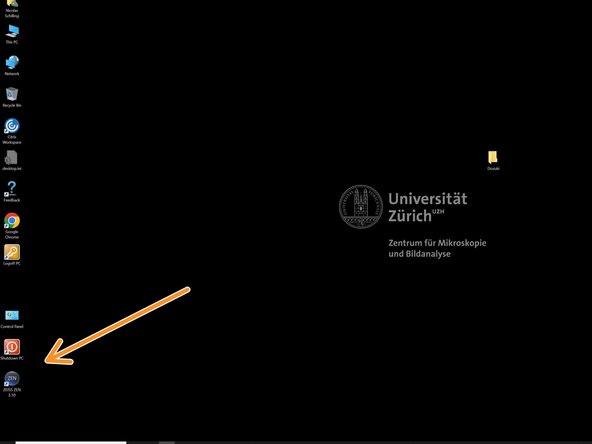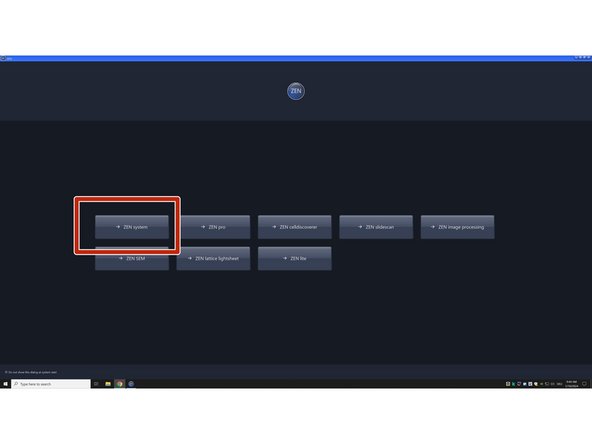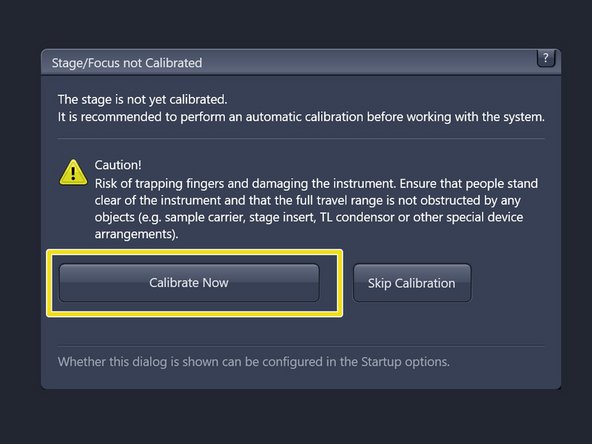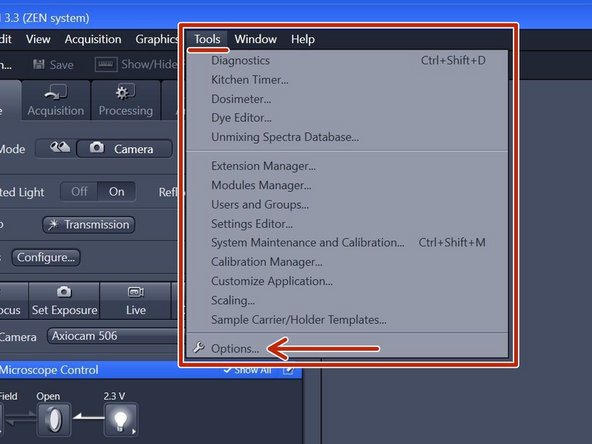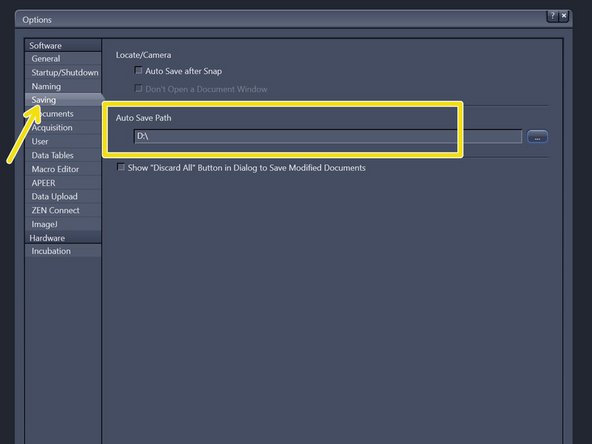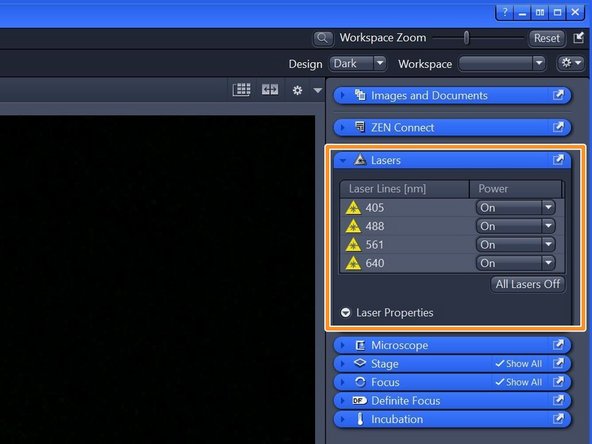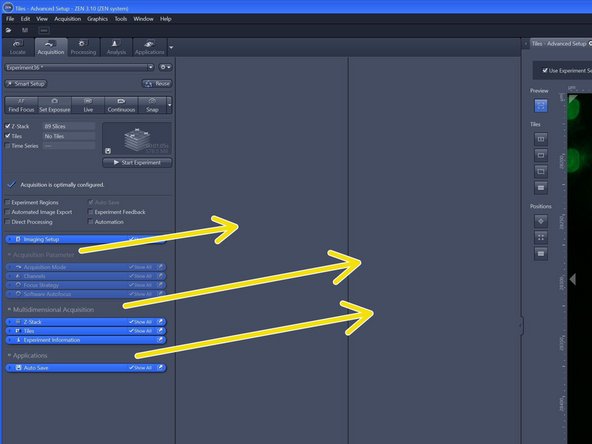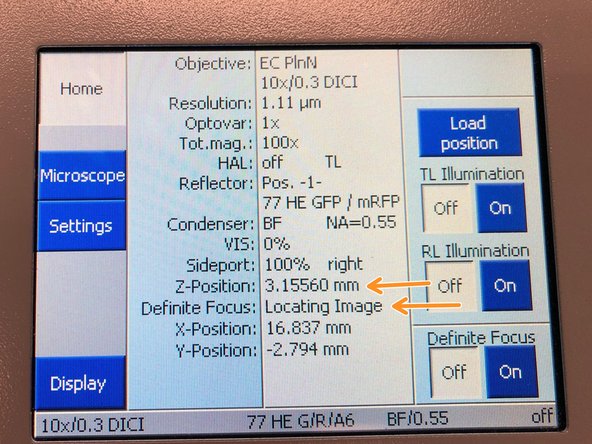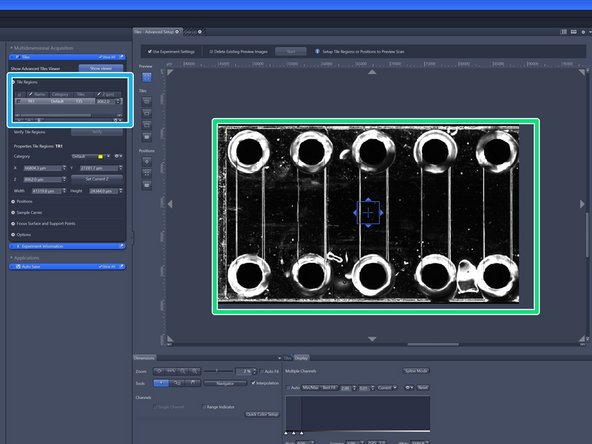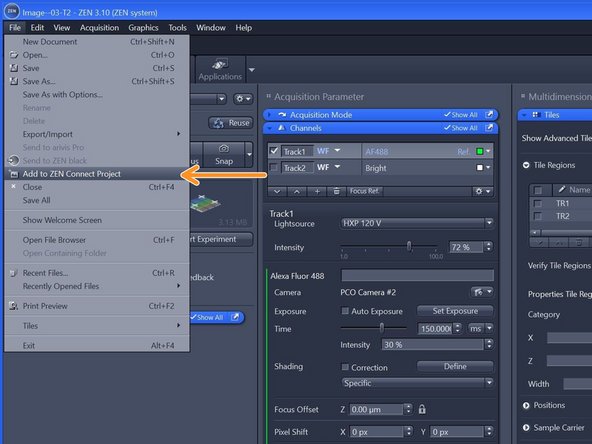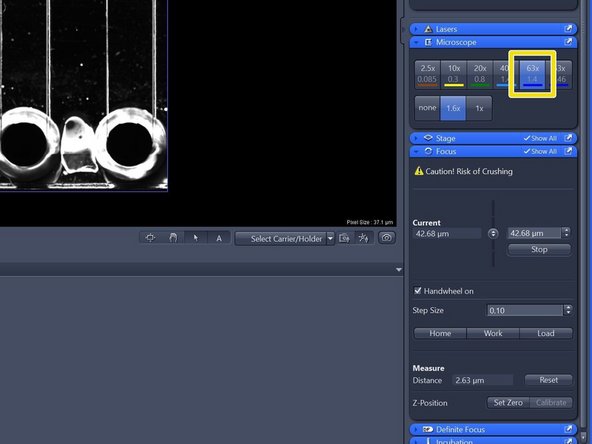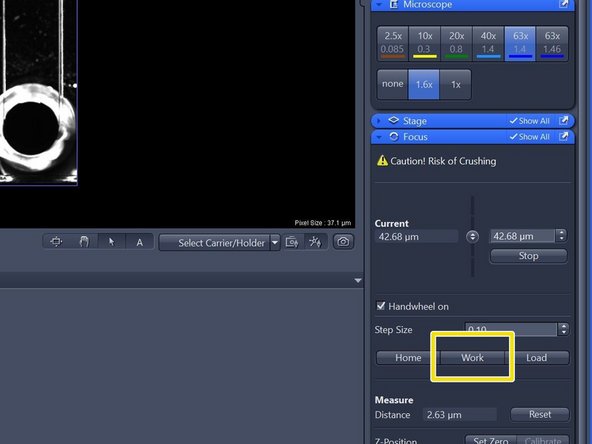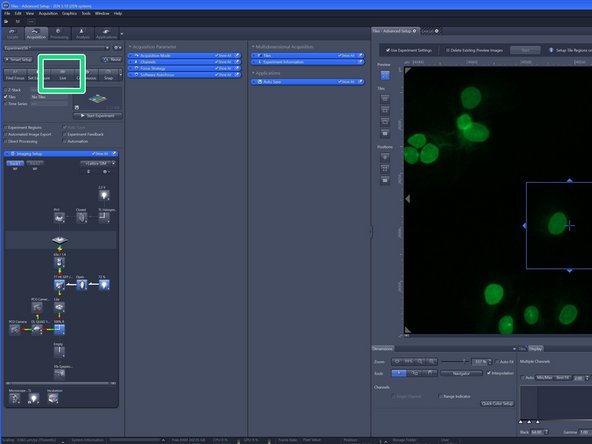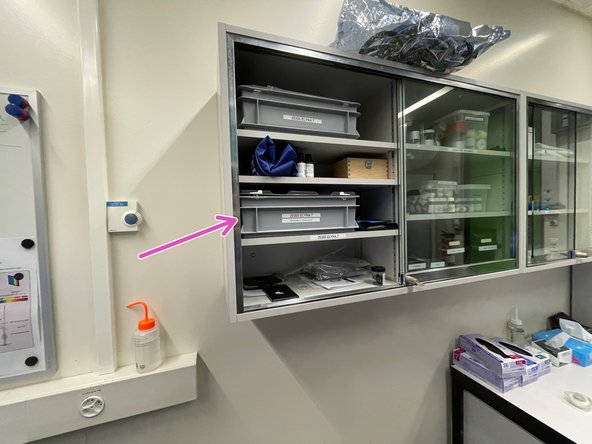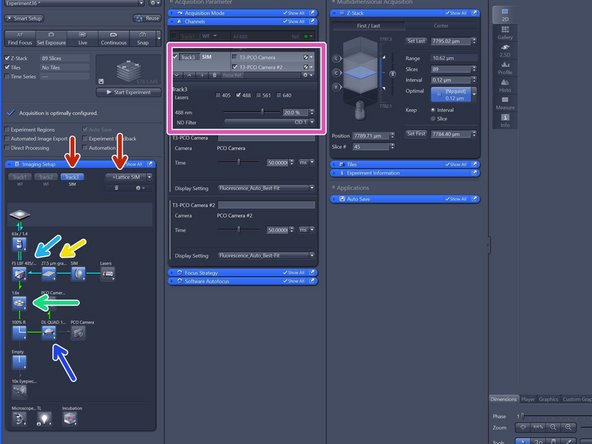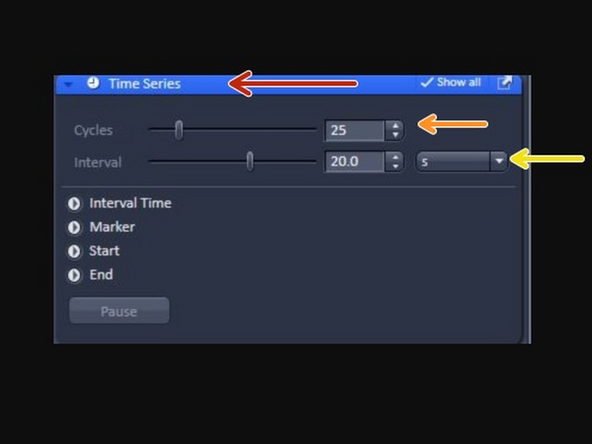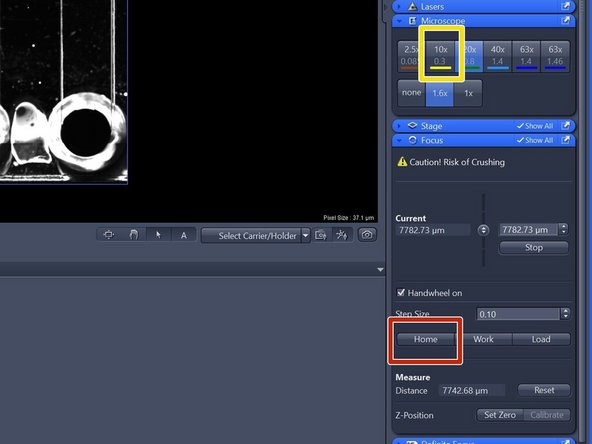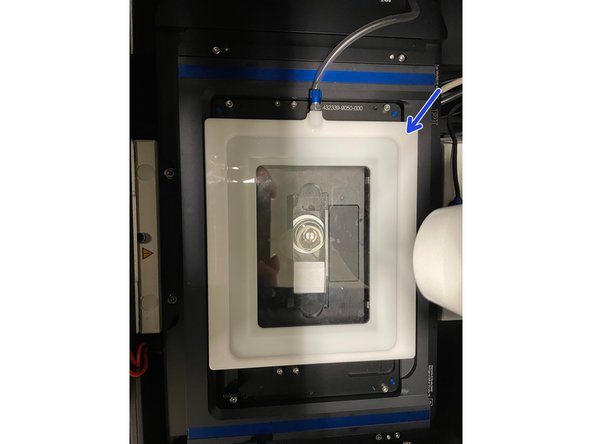Introduction
Please not that SIM has (as all techniques) its limitations. Therefore SIM might not work well in the following scenarios:
• Dense staining pattern: Excessive fluorescence is generated, which leads to an uncontrolled distribution of excitation patterns.
• Thick/refractive/scattering sample: The presence of these types of samples causes aberrations in the excitation wave pattern due to interactions and distortions.
• Sample movement during image collection: The mathematical assumption (reconstruction algorithm) of stationary samples is violated when the sample moves during the acquisition of the reference images, which affects the accuracy of the reconstruction.
• Weak signal: Low signal-to-noise ratio (SNR) results in the loss of valuable information, limiting the effectiveness of SIM in capturing fine details.
-
-
Turn on the HXP lamp.
-
Turn ON the "Main Switch" and also switch the laser key to "ON".
-
Switch ON the "Components" on the table.
-
-
-
Turn "ON "the computer.
-
For your information, the PC checks network cards in the background after being turned on. This means the display might stay black for 2-3 minutes before you see Windows booting.
-
Sign-in with your ZMB core credentials.
-
In case you forgot your password please follow this link.
-
-
-
Start the "ZEN Blue" software.
-
Choose "ZEN System".
-
Make sure there is no sample on the microscope stage and calibrate the stage by clicking "Calibrate Now".
-
The system will automatically initialize the hardware.
-
-
-
In the "ZEN" software go to Tools > Options.
-
Choose "Saving" and check that the "Auto Save Path" is set to the local Data (D:) drive. If not, please change accordingly.
-
Please generate a new folder with with your username. D:\ ZMB-USERNAME e.g. D:\m.mustermann.
-
This path setting is saved in your profile and should be retained even after logging out or restarting the microscope.
-
-
-
Click "View" - Show all global.
-
Make sure you have selected "2 Containers".
-
Switch on all lasers needed for your experiment.
-
Note: Red highliting indicates that lasers are still in warm up phase.
-
Drag and drop the "Acquisition parameters", "Multidimensional Acquisition" and "Applications" to the right in order to get more organized.
-
-
-
"ZEN Connect" correlates all data associated with your sample. It allows you to map high-resolution images on the larger overviews, maintaining the context and simplifying your file organization.
-
Choose "Create".
-
Alternatively, open the "ZEN Connect" tab and click "Create" (right hand side in "ZEN" software).
-
Define "Project Path" and "Project Name".
-
Click "OK".
-
-
-
Drag and drop "ZEN Connect.a5proj" file to the 2nd container (outmost container right hand side).
-
You need to grab the tab by the text in order to move it.
-
-
-
Add fresh milliQ water to the humidifyer bottle. You will find milli Q dispensing unit in Y42-H-88.
-
Open the "Incubation tab".
-
Activate the "H Unit XL" and "H Dev Humid" and set your desired temperature according to your needs.
-
We advise you to start heating up the temperature at least 40 minutes in advance. Make sure that the incubation box is fully closed while heating.
-
Open up the main valve and outlet valve of the CO2 bottle.
-
Do not adjust the reducing valve as it should be pre-set to 1 bar.
-
Open the blue gas channel for the ELYRA. (Note: In image currently closed).
-
Activate CO2 and set your desired concentration according to your needs.
-
-
-
Place you sample with the correspondin Click-In insert.
-
Make sure the frame locks securely into the stage completely flat.
-
-
-
The slide insert is compatible with the following formats:
-
µ-Slides by Ibidi
-
Nunc Lab-Tek™ Slides
-
Chambers by Thermo Scientific
-
Object Slides
-
PDMS Chips based on 25x75mm slides
-
-
-
Make sure you cover your sample with the CO2 lid which is usually stored within the incubator.
-
The white rubber sealing has to face the sample.
-
-
-
Insert the 35 mm Petri dish into the KM Frame.
-
-
-
Compatible with all kind of well plate formats.
-
-
-
Make sure you have mounted your sample and the 10X objective lense is bellow your sample.
-
Not that the following feature is not available for the 2.5X objective.
-
Open "Definite Focus tab" and click "Find Surface".
-
Definite Focus Settings are located on the right.
-
The microscope will perform a full range Z-scan and the Definite Focus will look for the strongest reflection signal.
-
On the touch panel you can monitor that the system automatically trys to find the covergalss reflection while moving through Z.
-
In Zen Blue the Definite Focus with Find Surface is not providing "Reflex found" as previously in ZEN Black 3.0.
-
If the refractive index mismatch between the immersion medium and glass is low, a reflextion might be too weak to be detected.
-
-
-
Open the "Imaging Setup tab" and define a classic wide-field track by clicking "WF".
-
Switch on the fluorescent lamp.
-
Make sure that FSe77HE filter is selected and the 1X tube lense.
-
FSet77HE is a triple band filter (Green-Red-FarRed) is the only filter for visual inspection.
-
Click on "live".
-
In case you have a black image click on "Min/Max" or "Best fit" in order to adjust the display of your image
-
When a reflex is found, this does not necessarily mean that the sample is in focus. Therefore, fine tune your focus with the coarse hand wheel by turning towards you.
-
-
-
Activate "Tiles".
-
Withing "Multidimensional Acquisition" open "Tiles" and click "Show viewer".
-
Choose the "Anchor Point Tool".
-
Drive the stage in "live view" to the top left corner of your sample carrier.
-
Set the first anchor point by clicking "+".
-
Drive the stage in "live view" to the bottom right corner of your sample carrier.
-
Set the first anchor point by clicking "+".
-
Confirm the Tile Area by clicking "Done".
-
-
-
Click "Preview".
-
Make sure "Use Experimental Settings" is activated.
-
Make sure "Delete Existing Preview Images" is deactivated.
-
Start the Overview acquistion by clicking "Start". Ideally use low magnifaction objective such as 2.5X.
-
Note: This overview will only be available as temporary preview, meaning it will not be saved automatically as raw data, eventhough "Use Experimental Settings" is activated.
-
Only when you click "Snap" or "Start Experiment" actual raw data will be generated and auto-saved into your ZEN Connect Project.
-
You can deactivate or delete the defined Tile Area.
-
You can now navigate on your overview and define more detailed overviews with different objectives or define multipositions etc.
-
-
-
Optional: In case you would like to keep / import previews into your ZEN Connect Project follow this step:
-
Right click on the corresponding preview and choose "Save Preview Images".
-
Save the preview into the same folder as you defined it in the beginning.
-
Click "Add to ZEN Connect Project".
-
Find now your preview imported into your ZEN Connect Project.
-
In case you would like to send an image to the back or front, use drag and drop in layers view.
-
-
-
Switch to the 10x or 20x objective and check that you are in focus.
-
In "Imaging Setup tab" click "Focus" and click "Load" - in order to lower the objective.
-
Change to the desired objective via the drop down menu.
-
Objectives suited for a certain imaging mode will be highlighted, but every objective can be selected.
-
Note that for SIM the Plan-Apochromat 63X 1.4 oil and for TIRF/SMLM the alpha Plan-Apochromat 63X 1.46 oil are the objectives of choice due to their optimized optics.
-
-
-
Remove the sample carrier plate.
-
Do not touch your sample within the carrier plate as this will disalign the overview.
-
Add a drop of immersion oil onto the objective lense.
-
Place the sample carrier plate again back in the frame and close the incubator box of the microscope.
-
Bring sample in focus by clicking on "work".
-
Click "live" and fine-tune your focus with the hand-wheel or with mouse and keyboard by keeping "ctrl" pressed and focus with mouse wheel.
-
Try to use the coarse hand-wheel and turn it slowly in your direction.
-
-
-
Select "SMLM" which is esentially LaserWF.
-
Choose the camera (PCO Camera or PCO Camera #2) depending on your fluorophores used.
-
Make sure 1.6 X tube lense is selected.
-
For WF imaging mode, Lens 1x is appropriate, for Laser WF, SIM Apotome and SIM imaging modes Lens 1.6x should be used.
-
Make sure you have "TIRF" mode activated.
-
Select via the reflector button the "LBF" filter and choose your SBS configuration.
-
Activate and adjust your laser lines. Note that OD1 is only 10% transmission meaning when laser power is set to 20% it is actually only 2%.
-
Adjust your required exposure time.
-
-
-
Activate both cameras.
-
Choose your SBS configuration.
-
Make sure tube lense is 1.6X.
-
Select your filter of choice. We recommend the LBF.
-
Activate two compatible laser lines based on SBS configuration.
-
Adjust exposure time. Note that when using dual link that exposure time is the same for both cameras.
-
Click live and and adjust the display by adjusting the histogram.
-
-
-
Click on "DuoLink" - click "Open alignment tool".
-
Insert "Callibration pattern" by activating it.
-
Click "XY" and wait for finishing.
-
Click "Z" and wait for finishing.
-
Please do not touch Rotation.
-
Note that the alighnment should only be judged in the center as at the edges it will be off due to lense distortion.
-
When done with the alignment remove the callibration pattern by deactivating it.
-
Please note that the alignment via the calibration pattern is only rough, in case you need a precise alignment please it manually with multi-spec beads.
-
-
-
Activate "Lattice SIM".
-
Check that "SIM" is selected.
-
Check that tube lense is 1.6X.
-
Choose your filter of choice.
-
Choose your SBS configuration based on your experiment.
-
Choose cameras and lasers accordingly.
-
Click "Grating" button to open the Grating selection. The system should automatically load the grating for optimal resolution enhancement, if this is not the case switch on and off lasers.
-
You can choose between an Empty position and 5 grid (G1-G5) with increasing spacing. The grating depends on laser line and objective used. Not that the SIM grid pattern will always be adjusted to the higher wavelength when using dual camera.
-
-
-
Click "Continous" in order to apply all imaging parameters to see SIM modulation contrast on your sample.
-
In "Acquisition Mode":
-
You can adjust your frame size.
-
You can adjust your grating. More phases will result in more modulation information meaning and better resolution.
-
For highest temporal resolution in order to capture ultra-dynamic events we advise you to use 9 phases for live-cell experiments.
-
In any Lattice SIM experiment, you will acquire several images per plane, 9 phases are recommended for live cell imaging. The light dose reaching your sample is higher than in a standard widefield imaging approach, resulting in increased bleaching and cell stress.
-
Hence very long timelapses are difficult to achieve. High bleaching will always show up in the reconstruction process, it will cause more artefacts to appear.
-
-
-
Activate "Z-stack".
-
In case "First/Last" option is selected, move to the start of your Z-stack with the hand-wheel and click "Set First", then move to the end of your Z-stack and click "Set Last".
-
In case "Center" option is selected, move to the center of your Z-stack with the hand-wheel and click "Center".
-
Click "Optimized" to have ideal sampling for your Z-dimension.
-
Optimal sets interval to match the Nyquist criteria (2 fold over sampling) and accordingly adjusts the slices to keep the range within the limits defined.
-
Leap sets the spacing 3 fold broader than Nyquist.
-
Note: For SIM it is important to define your Z-stack in the range of the modulation contrast otherwise SIM processing will be less effective.
-
An alternative to "Optimized" is "Leap" especially for live-cell in order to acquire 3X faster Z-stacks as only every 3rd plane is acquired and the missing ones are artifically calculated.
-
-
-
Activate "Positions".
-
Select ROI by navigating in your overview and click "add" to add a position.
-
Note: Multipositioning can be combined with Time Series and/ or Z-Stacks.
-
-
-
Open "Time Series tab".
-
Define your "Cycles" (how often your experiment will be repeated) according to your experiment needs.
-
If you have a defined timespan you want to run the experiment for, you need to calculate how many cycles you need: For example: 500ms interval => 2 images/s (1000ms = 1s and 60s = 1min) => 120 images/min This means if you want to image for 10 minutes you need 1200 cycles.
-
Define an "Interval" according to your experiment needs.
-
Interval refers in this case to the time from the start of one complete image to the start of the next one; in the drop-down box you can choose between ms, s and min. For example: In case you defined cycles to be 25 and interval 0.0 ms, your exposure time is 50 ms then read/ transfer time is ca. 2 ms in this example.''
-
When using Lattice SIM with 9 phases per focal plane takes 468ms per complete image. To ensure a reasonable interval between images, one must choose a duration longer than 468ms. There is no warning if the system requires more time than the specified interval, and the system will continue imaging as quickly as possible without any wait time.
-
Note that Burst mode post-processing is only available if NO-Interval is set and 2D data is acquired.
-
Open the "Information on Experiment tab" in order to see what the duration of 1 frame is.
-
-
-
All your raw data is auto-saved when ZEN Connect Project is active.
-
Open "Add Format-IDs"
-
Define your sample information: Name, Prefix, Suffix.
-
Click in "Format" - erase everything to start from scratch.
-
Double-click the desired "Format IDs" to add them to the "Format" section, which will also activate an auto-counter.
-
-
-
Click "Focus" and click "Home".
-
Remove your sample.
-
Clean immersion-objective with lens paper and Isopropanaol.
-
Change to the 10X air objective.
-
Make sure your data is saved.
-
Check booking system if anyone booked the system within the next 2 hours:
-
If yes just log off.
-
If not shut down the computer, then switch OFF the "Components" on the table, then turn OFF the "Main Switch" and finally turn OFF the HXP lamp.
-
-
-
Close the oulet-valve and the main valve of the CO2 bottle.
-
Only if no one is doing live-cell experiments at the LSM980 Airyscan.
-
Close the gas supply channel to the ELYRA.
-
Empty the milliQ water in the humidifyer bottle and clean with 70% EtOH.
-
Fix the CO2 cover with tape to the side of the incubator.
-







